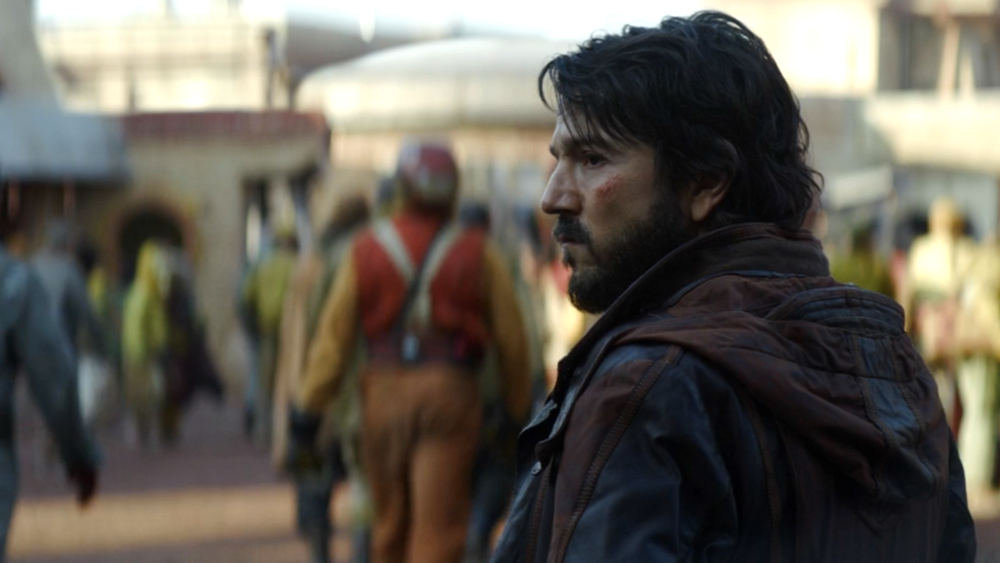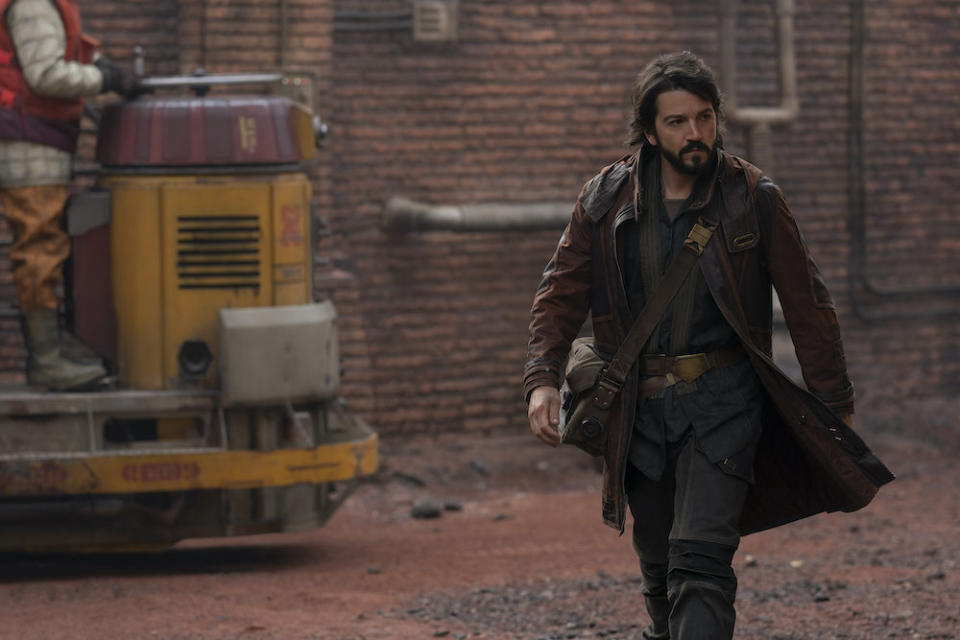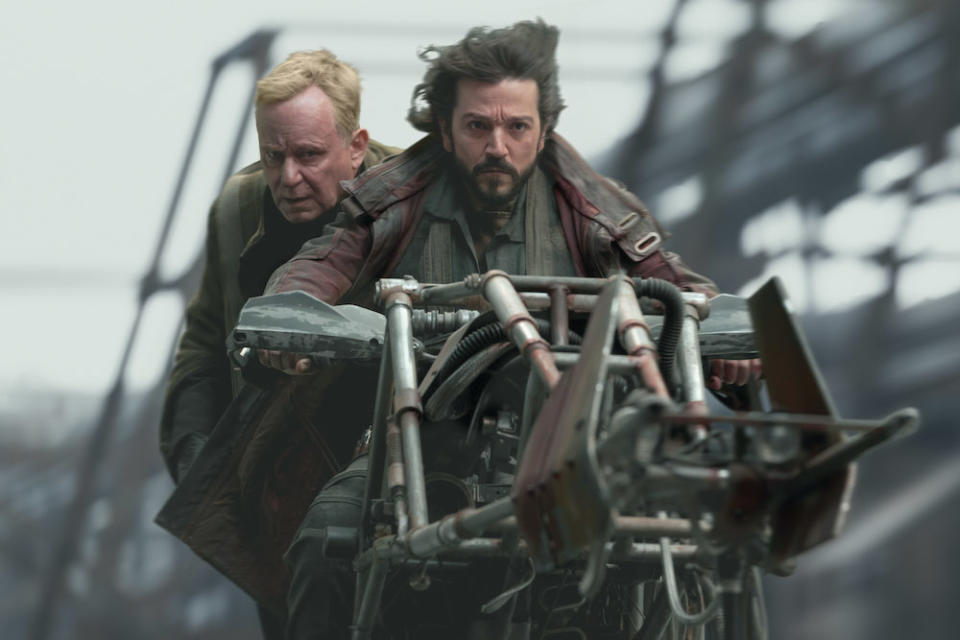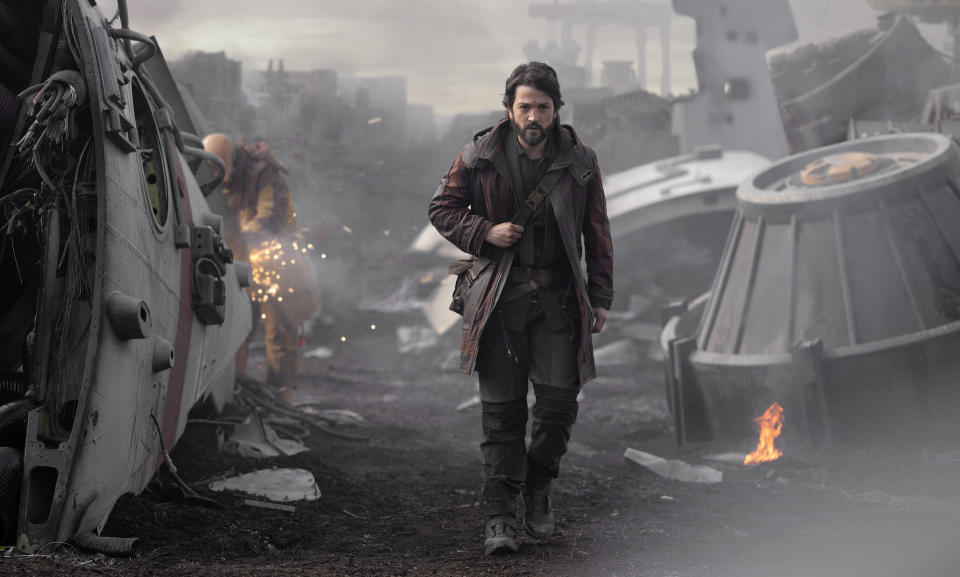‘Andor’: Shaping the Spy Missions, Heists, and Flashbacks That Lead to ‘Rogue One’

- Oops!Something went wrong.Please try again later.
- Oops!Something went wrong.Please try again later.
- Oops!Something went wrong.Please try again later.
Midway through Season 1 of “Andor” (streaming on Disney+), it’s very clear that this is like no other “Star Wars” series. Showrunner Tony Gilroy has us hooked with his gritty spy thriller-meets-wartime heist about scavenger-turned Rebel spy Cassian Andor (Diego Luna). It should come as no surprise given what Gilroy previously achieved as the screenwriter of “Rogue One: A Star Wars Story” and “The Bourne Identity,” and as writer-director of “Michael Clayton.” His “Rogue One”origin story is the kind of nuanced, slow-burning character study “Star Wars” fans have been waiting for, filling in the details of a complex loner who will eventually light the fuse that ignites the rebellion against the Empire.
“Andor” is a Gilroy sibling collaboration, with Tony joined by screenwriter-director Dan (“Nightcrawler) and editor John (who also cut “Suicide Squad” and “Pacific Rim”). Although Lucasfilm and Disney+ initially wanted a five-season commitment, with each season spanning one year leading up to the events of “Rogue One,” they settled on two 12-episodes seasons. The episodes were grouped into three-block mini-movies, split up among directors Toby Haynes, Susanna White, and Benjamin Caron. This came in handy for John Gilroy, who cut the first three episodes together for the premiere.
More from IndieWire
California Bakery Crafts 'Pan Solo,' Life Size Han Solo Statue Made Out of Bread
Kevin Smith Will Never Direct a Marvel or 'Star Wars' Movie Because It's a 'Fool's Errand'
“You come from the feature world and on every big movie, you’re always worried about running time from the very beginning,” he told IndieWire. “You shoot too much or the script’s a little flabby. Sometimes you can break a story if it’s compacted too much.” According to the editor, that wasn’t a concern with “Andor,” thanks to the vision his brother brought to the project. “Tony had a such a wonderful idea and blueprint and the shooting scripts were very good,” he said.
In keeping with the tactile and visceral sensibilities expressed in Tony Gilroy’s feature work, a great deal of “Andor” was shot on location. Forgoing the ILM StageCraft LED wall used by its Disney+ predecessors, “Andor” set up shop around the U.K. and at London’s Pinewood Studios; the production even constructed the mining city on Ferrix (seen in the first three episodes) as a standalone, outdoor practical build containing several city blocks. John Gilroy called StageCraft “an amazing tool,” but one that “wasn’t for this show.” “We needed the flexibility of a more conventional shoot where there’s a lot more choices available,” he said.

Des Willie / Lucasfilm Ltd.
John Gilroy worked on the first three-episode block with editor Tim Porter (“Game of Thrones”) and Episode 6 with editor Dan Roberts (“Peaky Blinders”). The other episodes were edited by Hazel Baillie, Frances Parker, Matthew Cannings, Simon Smith, and Yan Miles — Gilroy wanted to share editorial duties in a fully collaborative back-and-forth for his first TV gig. This was important to him in setting up the world of “Andor” and establishing Cassian’s character arc. As his brother previously put it, “How does a nobody, absolute nobody, forgotten, careless nobody, become this incredible person?”
That journey begins with a pair of deaths at Cassian’s hands — the first accidental, the second an attempt to cover his tracks — before his flight from that sticky situation leads to recruitment from the fledgling rebellion. But what’s refreshing about “Andor” is how it takes its time exploring Cassian’s childhood trauma through a series of emotional flashbacks throughout the first three episodes. These scenes tell us everything we need to know about his dire situation and ambivalence concerning his place in the galaxy. “Like any show, you need to set the table and understand what’s going on, but I think everyone is going to be surprised where this show goes,” John Gilroy said.

Des Willie / Lucasfilm Ltd.
“Andor” is populated by a rich ensemble, including Syril Karn (Kyle Soller), the Javert to Cassian’s Jean Valjean; Luthen Rael (Stellan Skarsgård), the master spy for the rebellion (posing as an eccentric antique dealer), who recruits Cassian for his first mission; the iconic Mon Mothma (Genevieve O’Reilly), the Imperial senator and double agent who helps form the Rebel Alliance; and Maarva Andor (Fiona Shaw), Cassian’s adoptive mother, who rescued and nurtured him and tries to steer him away from his worst impulses.
“You’re setting up characters and showing where [Cassian] is in his life, which is lost,” added John Gilroy. “And he’s on everybody’s shit list. He’s got a lot of great qualities and doesn’t quite know where he fits in, and so he’s malleable. It was interesting because you’re also trying to find your groove in the first three episodes and the flashbacks with the kid. The way we intercut the exodus of Luthen and Cassian in the ship at the end of Episode 3 with the introduction of Maarva in the ship with Cassian as a boy is very effective.”
The highlight of that episode is the visually stunning firefight in a factory between Luthen and Cassian and a dozen security officers dispatched by Karn. At first, Cassian merely wants the payment for the Imperial navigation device that he sees as his ticket out of Ferrix, but Luthen craftily recruits him by stroking his ego and appealing to his thirst for revenge against the Empire. “Wouldn’t you rather give it all at once to something real than carve off useless pieces till there’s nothing left?” The back and forth between them is delicious, which sets up the thrilling shootout. “You have a lot of freedom because Tony planted a lot of seeds and charted a lot of new territory and characters,” added Gilroy. “It was an opportunity to swing out in the middle and the choice of the factory setting [by production designer Luke Hull] really helped a lot.”

Des Willie / Lucasfilm Ltd.
The climax of Season 1’s second block proved to be the perfect test for Cassian, who displays many of the legendary skills that will serve him well in “Rogue One” — he’s a great strategist, fighter, and pilot, as well as a ruthless survivor, which he demonstrates by shooting the selfish Skeen (Ebon Moss-Bachrach) after he betrays him and the team. The mission, of course, nearly fails, if not for Cassian’s inspired leadership, and the editing leans on the strength of the performances and suspense. “You have to know your geography and make sure the viewer isn’t confused by what’s going on,” John Gilroy said. “But, again, it was all in the script, and we just needed to make sure we had the coverage we needed.”
It wouldn’t be “Star Wars” without an exciting getaway from TIE fighters in a colorful meteor shower (courtesy of ILM). Yet in the end, whether Cassian realizes it or not, he’s passed the point of return. He takes off with his payment, but he also accepts the Rebellion Manifesto of fallen colleague Nemik (Alex Lawther). “Every block is quite unique, and one of the things that I’m most proud of is how the whole thing comes full circle for the season,” John Gilroy said. “It’s a very satisfying, coherent arc.”
And what about next season, which will be more compressed? John Gilroy added that “Andor” will jump years between blocks, leading to the “Rogue One” endpoint. He believes that after the series is completed, it will be a great opportunity to revisit and reassess the “Star Wars” standalone that many believe is the best of the franchise’s post-Lucas movies.
Best of IndieWire
From 'Reality Bites' to 'Fatal Attraction,' Keep Track of All the Upcoming Film-to-TV Adaptations
7 New Netflix Shows in October 2022 — and the Best Reasons to Watch
Sign up for Indiewire's Newsletter. For the latest news, follow us on Facebook, Twitter, and Instagram.


